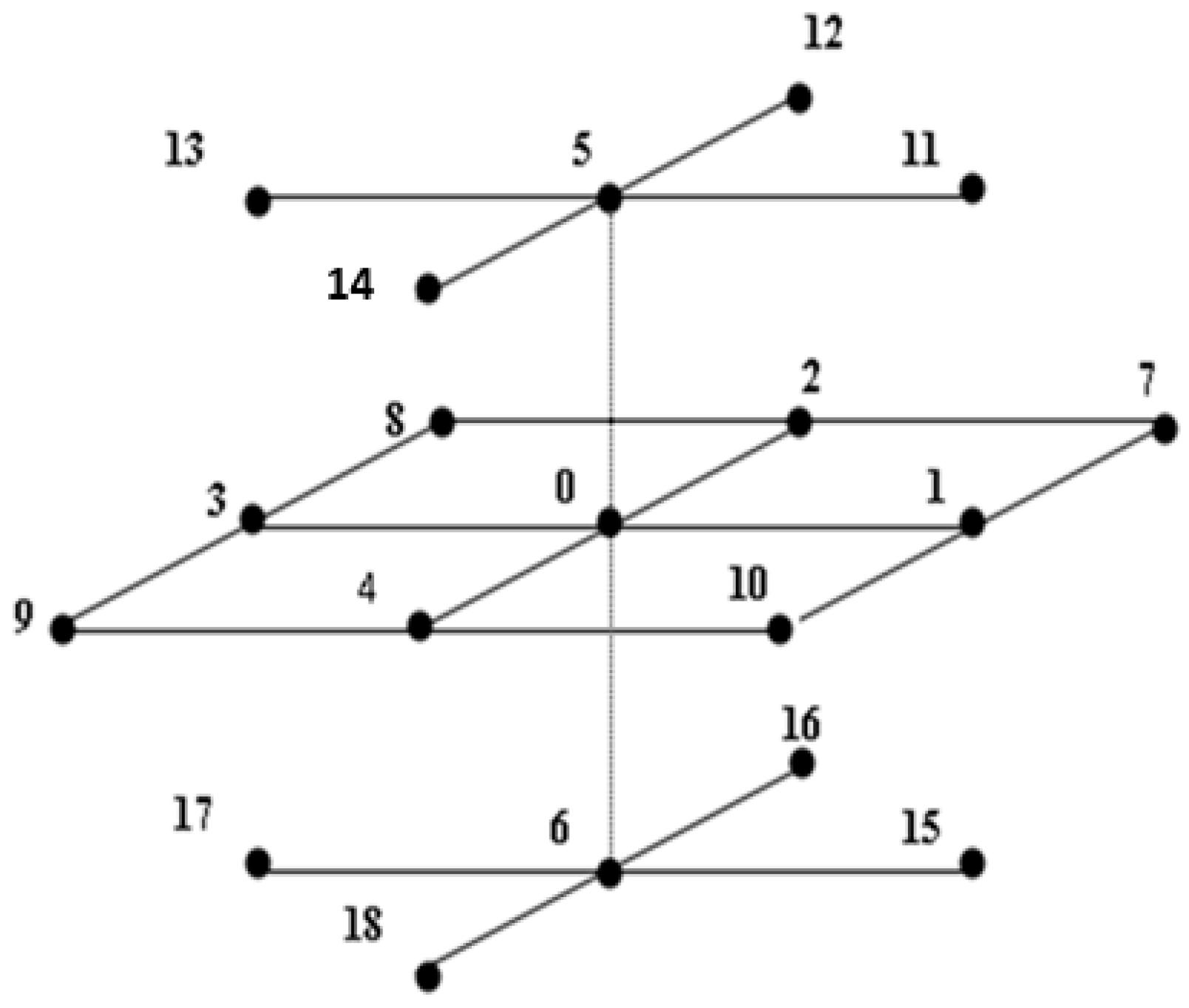We consider the 3D unsteady reaction diffusion equation using Dirichlet boundary conditions. We will discuss how to design the fourth-order compact scheme for solving the 3D unsteady reaction diffusion equation in the following.
2.1. HOC Main Scheme
Consider the unsteady form of the following equations:
Assume that the problem domain is rectangular and and are constants. is the boundary and is the time interval. is the positive constant diffusion term coefficient, is the unknown function, is the nonlinear source function term, and are the smooth functions. We discretize the domain with uniform grids and split as meshes ; set to be the temporal grid step length and to be the spatial grid step length in the , and directions. The grid points are labeled as where and and
For the sake of simplicity, we use
Figure 1 to denote the placement of the 19 points. We number the mesh points
,
,
,
,
,
,
,
,
,
,
,
,
,
,
,
,
,
and
as
, respectively.
The details of the finite difference operators are given as follows:
The model Equation (1) can be rewritten as follows:
Using the Taylor series expansions at the grid point
, we have
To keep the scheme compact, the fourth derivatives need to be discretized. We differentiate Equation (6) with
,
, respectively as
Then, we substitute Equations (7)–(12) into Equation (6) to obtain the following difference equation:
Omitting the truncation error term, we derive a compact difference scheme as the following:
To obtain an HOC scheme based on the mixed time derivatives
in Equation (15), we only need to use the following second-order backward Euler formula [
19] for discretization:
The following is the fourth-order backward Euler formula [
19] for the time derivative in Equation (15):
Finally, substituting Equations (16) and (17) into Equation (15), neglecting the higher-order truncation error terms, and letting the mesh ratio be
, the present HOC scheme can be rewritten as follows:
Equation (18) is the new HOC scheme we developed. It is easy to see from the derivation process that the truncation error of this scheme is
, which means that the present HOC scheme has fourth-order accuracy in both time and space. It should be noted that only the spatial dimensions are compact in this scheme while the temporal dimension is not compact, since it involves five time levels. According to the conclusion in [
19], the backward Euler formula is unconditionally stable when the accuracy is not higher than the sixth-order; therefore, we used the second-, third- and fourth-order backward Euler formulas in this paper; the HOC scheme is unconditionally stable.
2.2. HOC Schemes for the Start-Up Layers
We note that the scheme involves five time layers. In addition to knowing the initial value of the moment, it is necessary to obtain the values of the first, second and third time layers before we can move forward time. To ensure the accuracy of the schemes, we consider the value of Equation (18) at the moment
using the Crank‒Nicolson method and Equations (16) and (17) are replaced by the following equation:
We simplify this equation to obtain
As seen from Equation (20), at time , the value of the first time layer can be solved; in addition, at time , the value of the second time level can be solved. The truncation error of this scheme is .
To obtain the value of the third time layer, for the mixed derivative term containing the time, the second-order backward Euler Formula (16) is adopted for discretization, and the third-order backward Euler formula can be used for the time derivative. Thus, Equation (17) is replaced by the following Equation [
19]:
Letting
, Equation (20) can be written as
The truncation error of this scheme is .
According to the above analysis, the HOC scheme is a fourth-order five-layer fully implicit scheme, and the scheme is unconditionally stable. That is, the HOC scheme in this paper can achieve fourth-order accuracy in both the spatial and temporal dimensions. For the HOC scheme, if we set
, the first time and the second time layers keep an order of magnitude of
; the third time layer keeps an order of magnitude of
; and after the fourth time layer, the temporal dimension can achieve fourth-order accuracy. Therefore, the first three start-up layers have lower-order accuracy than the fourth-order accuracy. According to [
19], the use of a second-order accuracy scheme to initialize a fourth-order accuracy scheme appears not to affect the overall order of accuracy because the cumulative error phase is relatively small due to the small number of advanced layers. The numerical experiments in
Section 4 will also fully illustrate this point.






